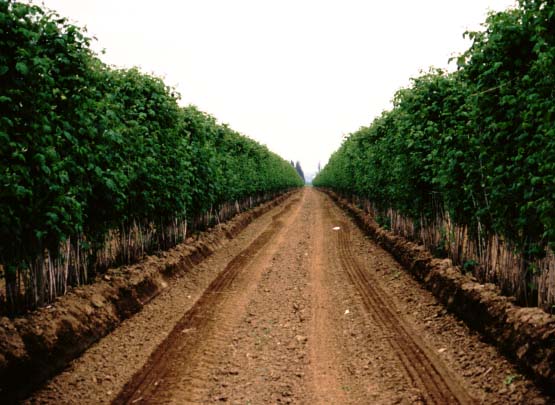Figure 12
Figure 13
Economic Significance:
The Pacific Northwest region of North America including the Willamette Valley of Oregon, parts of Southwest Washington and the Fraser Valley of Northern Washington and Southwest British Columbia, are the primary producers of red and black raspberries for the continent. The economic impact of raspberry bushy dwarf virus has been substantial for the raspberry industry. If red raspberry plants remain healthy, they can produce fruit for 15-20 years on a commercial basis. If a field is infected with RBDV (Figure 12), it needs to be replanted on a five or six year cycle because the yield and quality losses are too great for the grower to maintain any profit margin. Since the fruit is crumbly (Figure 13) it can only be sold to the juice and jam market which averages $.25-.28 per pound. If the fruit were healthy it could be sold to the fresh market or as IQF (individually quick frozen) for $.75-1.25 per pound. Add this profit loss with the cost of replanting every five years (approximately $3500/acre) and red raspberry growers are losing about $1000/year/acre due to RBDV.
It has been suggested that RBDV originated in Europe and has been introduced
into all major raspberry production areas of the world with infected planting
stock (Stace-Smith, 1984). The virus is common in Europe, Asia, North
and South America and Australasia. With increased planting of susceptible
cultivars due to their improved horticultural characteristics and the development
of a resistance breaking strain of RBDV in Europe this virus has become
much more of a problem since the early 1990’s. In many parts of the
world planting of raspberry increased dramatically during the early 1990’s
because of a significant increase in prices that coincided with the war
in former Yugoslavia – formerly the worlds largest producer of red raspberries.
Nowhere was the increased planting more dramatic than in the Fraser River
valley on the western US and Canadian border. During the 1980’s the
resistant cultivar ‘Willamette’ had been replaced by the susceptible cultivar
‘Meeker’. This combined with the dramatic increase in arceage, also
all the susceptible cultivar ‘Meeker’, resulted in a monoculture of a single
susceptible cultivar and the situation for an epidemic was set up.
Large acreages of a susceptible host, all in bloom at the same time, presence
of RBDV in native Rubus (Martin, 1998) and the epidemic was on. As
RBDV became well established in ‘Meeker’ raspberry the inoculum level increased
and new plantings were becoming infected sooner and sooner after planting.

